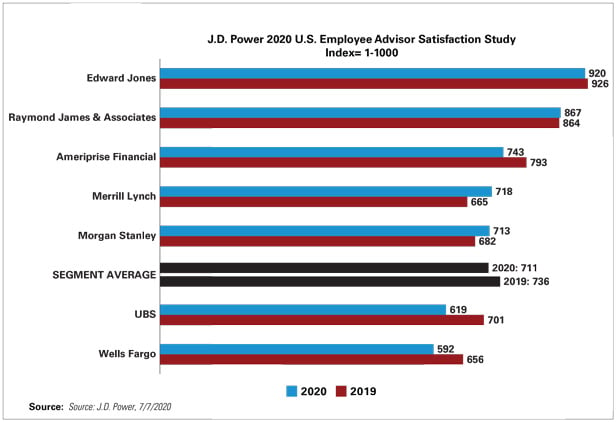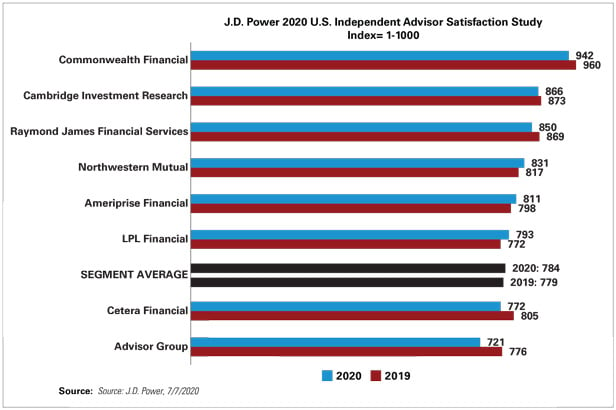Wealth management firms have been adding technology — before and during the pandemic — so their advisors can work better with market data, client information, account servicing tools and AI-powered analytics. But is this making a difference?
“While firms are investing heavily, many have been missing the mark on delivering technologies that truly meet advisor needs,” according to Mike Foy, senior director of wealth and lending intelligence at J.D. Power, which released its yearly U.S. Financial Advisor Satisfaction Study on Tuesday.
“In fact, just 48% of advisors say the core technology their firm currently provides is ‘very valuable,’” Foy said. “That needs to change if firms want to win the talent war.”
Overall, the 3,262 advisors polled by J.D. Power — both employee and independent advisors — are less satisfied with the majority of firms they work with in 2020 than they were in 2019.
For instance, the average level of satisfaction of employee advisors dropped to 711 (on a 1-1,000 scale) this year from 736. And four of seven firms in the survey had lower advisor-satisfaction levels than in 2019.
On the independent side, the average level of advisor satisfaction rose to 784 in 2020 from 779 a year ago. However, five of eight firms in the survey saw their average satisfaction figures drop this year.
New Survey Focus
J.D. Power redesigned the advisor satisfaction study for 2020.
It now measures satisfaction based in these six categories: compensation, leadership and culture, operational support, products and marketing, professional development, and technology.
In recent years, it based the satisfaction survey around these seven areas: client support, compensation, firm leadership, operational support, problem resolution, professional development and technology support.
Key Survey Findings
When releasing the latest survey results, J.D. Power also highlighted the following four takeaways:
1. Better technology counts: Advisors’ perception of improvements in their firm’s technology has become the most significant indicator of advisor satisfaction, for both employee and independent advisors.
2. There’s a big disconnect between reliance on technology and its perceived value: Most advisors, 92%, say they rely on core planning, portfolio allocation, portfolio management and customer relationship management technologies that their firms provide — yet a minority, 48%, see these tech resources as “very valuable.”
3. Predictive analytics show promise: Advisor tools such as those driven by artificial intelligence can help advisors predict client needs and identify at-risk clients; they have relatively low levels of adoption, 9%. For advisors who do use them, their satisfaction with their firms’ technology is 95 points higher (on a 1,000-point scale).
4. Integration matters: Currently, just 21% of advisors say their platforms are “completely integrated” with features such as single sign-on, data-synching and workflow. Advisors rate firms with integrated platforms significantly higher in tech satisfaction vs. those that don’t have it — with a 276-point increase among employees advisors and 193-point increase among independents (on the 1-1,000 scale).
— Related on ThinkAdvisor:







 July 07, 2020 at 03:38 PM
July 07, 2020 at 03:38 PM















 Slideshow
Slideshow





